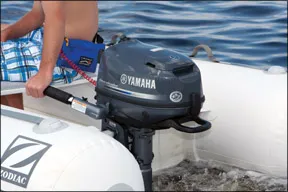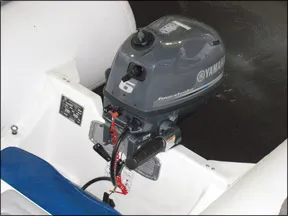It seems the only people who dare label a 75-pound outboard engine “portable” are marketers and engine manufacturers (and perhaps, He-Man). In the world of small sailboats and dinghies-where outboards usually are not permanently mounted-engines with 8 horsepower or more are typically too heavy to take on and off the boat frequently. While Practical Sailor wouldnt exactly call 4- to 6-horsepower four-strokes light, they are manageable, and manufacturers have been working to make some newer models even lighter.

Photo (top left) courtesy of Yamaha Motors
Yamaha recently updated two of its F-series portable outboards, the F4 and the F6. Practical Sailor had the opportunity to field-test them on a Zodiac Cadet 260 Air Lite inflatable boat, and testers noted several improvements over the previous 4-horsepower and 6-horsepower models.
We reviewed the original Yamaha F4 in the December 2003 issue and the F6 in the March 2003 issue. In those reviews, the F4 garnered an Excellent for portability due to its light, 49-pound weight, but the F6 was the heaviest engine in the 6-horsepower test field. Neither engine rated well for storage, and the F4 received mediocre scores for ease of starting.
The new F4 and F6 PS tested share similar design traits, the most notable of which is that they use the same 8.5-cubic-inch engine block and both weigh 60 pounds. Thats an improvement in portability for the F6, formerly 83 pounds, but it means an additional 11 pounds for the F4 and an increased displacement; the previous F4s displacement was 6.8 cubic inches. Yamaha achieved the F6s weight loss by switching from a two-cylinder powerhead design to a lighter, single-cylinder powerhead.
The F4 update addressed PSs grievances of the original model. The new F4 was much easier to start than its predecessor-it fired up with one pull while the tester was seated in the Zodiac-and its simpler to stow. It can be rested in three horizontal positions (on the face and port and starboard sides) without oil leakage. The previous F4 had to be stowed on its tiller side, which required reinforcement to make it stable. Another storage-friendly feature is the auxiliary primer pump, which primes the fuel system after a long period of non-use.

The F4 and F6 also share many functions and features, including 180-degree steering and an angled fuel-fill opening to help reduce the possibility of spills, according to Martin Peters, Yamaha communication and dealer education manager. Yamaha also lowered vibration levels. Engineers utilized a balanced crankshaft that counters the weight of the piston and connecting rod, yielding smoother operation, Peters said. The PS tester reported that vibration, while low for a one-cylinder engine, was still noticeable.
Testers found shift levers on the new models (on the forward section of the engines starboard side) easy to reach, and the motor transitioned from neutral into forward and reverse smoothly.
With some small outboards, releasing the engine from its locked position for tilting is a frustrating process. But our tester raised and lowered the Yamahas on the inflatables transom without cursing or fussing.
The older F4s came with large front carrying handles that testers reported made transporting the engine easy. The new models forgo these for an integral lip in the lower cowling that serves as a grip and allows the engine to rest on its face. Its an understandable tradeoff, and both the F4 and F6 now have large carrying handles at the aft end of the cowling.
The stop button with kill-switch lanyard attachment, choke, and fuel-line attachment are on the face of the engines. You remove the cowling via a single clamp on the engines aft end.
The new F4 and F6 both have 1.1-liter integral fuel tanks that can be sight checked, and users can monitor oil level via an oil reservoir viewing window, a feature the previous models lacked.
Testers werent impressed with the get-up-an-go ability of the older F4, but they found the updated model operated smoothly.
The top pick in the 2003 tests 4-horsepower group was the 55-pound Suzuki DF4 (www.suzuki.com), which was easy to start, showed a solid performance, and had smooth shifting. The average online price we found was $1,025 for the DF4, compared to the new F4s $1,267. The updated F4 definitely gives the Suzuki a run for the money when it comes to features, stowage and starting, but the added bulk is a drawback.
In the 2003 6-horsepower outboard evaluation, testers liked the Yamaha F6 but really knocked it for the weight and stowage. Now that those issues have been resolved, the new F6 is a true contender in its power range.
Bottom line: The new F4 and F6 from Yamaha start easily, have better stowage capability, and shift smoothly-improving on their previous models and putting them on par with the top picks of the 2003 tests.








































Would like to know what the experience is with small outboards and salt or brackish water. There is talk on some of the online forums that Suzuki does treat the interior coolant passages for corrosion resistance and are more susceptible to that corrosion and ultimately failing due to poor/no coolant flow. It is said that Suzuki tells owners they have to do a fresh water flush after every use in salt or brackish water.
Is this a real concern and does it only apply to Suzuki?